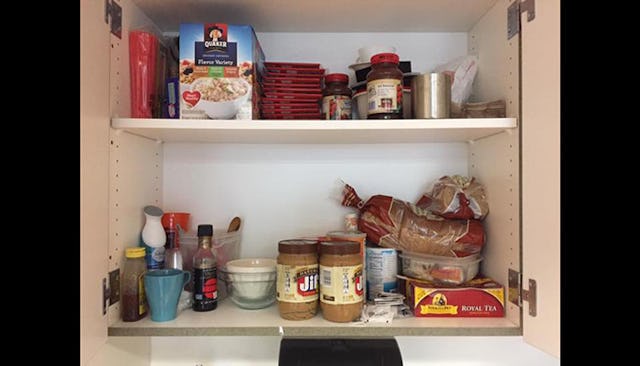Teacher Shares Photo Of The 'Invisible Safety Net' She Provides Her Hungry Students

Teacher shares photo of the food pantry she keeps stocked to feed hungry students
In 2015, 13.1 million children lived in food insecure households. 14.5 million children under the age of 18 were living in poverty. For many of us, it may be hard to grasp that this many children live with the reality of hunger. But for those who are a part of these kids’ lives everyday, it comes as no surprise.
RELATED: What Is Classroom Management, And How Can You Apply It At Home?
A teacher shared a photo last spring that many may find surprising: it’s of the food pantry she keeps stocked in her high school classroom, to ensure that her students never have to feel hungry.
“We are your children’s teachers. We know that we may have more time with your child than you do. We don’t want them to be hungry, and not just because a hungry child can’t learn but because we care about them,” she began her post. “Hungry feels scary.”
Katherine Gibson Howton teaches at a small high school in Oregon. She tells Scary Mommy that 20% of the students in her school have housing insecurity and a high percentage qualify for free or reduced lunch.
“Almost every teacher I know has a cabinet in their classroom with emergency food for their hungry students. This is the cabinet I share with another teacher, Julie Mack. Children come into our classroom everyday telling us they are hungry,” she explained in her post. “Many more never say a word because they are embarrassed and it is up to us to notice that they are distracted, tired, grumpy. Skilled and compassionate teachers learn to ask if there is food in the house and when was the last time you ate? And the really skilled teachers just know when to make an extra sandwich, grab an orange, make a bag of popcorn or bowl of oatmeal, and set it in front of a student and tell them to eat.”
“We know that some of our students have no food in the house by the end of the month,” she told Scary Mommy. On one occasion, a student had her head on her desk complaining of a headache. When Howton asked what was wrong, the student answered, “I haven’t eaten all day.”
When she realized how often she was feeding kids in her classroom, she asked her colleagues, “Do you provide food for your students?” An overwhelming majority answered, “Yes.”
“I asked my colleagues, ‘Do you find it weird that we’ve never talked about it?’ If we as educators aren’t talking about it, how could parents possibly know?”
Howton also shared her image on the Pantsuit Nation Facebook page, where thousands of comments began rolling in. Many thanked her for being an awesome human being, but nearly all the educators that chimed in admitted to having a similar set-up in their classrooms: drawers full of protein or breakfast bars, cupboards full of snacks. When we asked Howton if she’d like to share the name and location of her school, she said, “It’s not about me, or my classroom, or this school — it’s universal. I’ve even seen substitute teachers and administrators do it.”
Last March, White House Office of Management and Budget Director Mick Mulvaney said of after school programs that provide free meals to students, “There’s no demonstrable evidence they’re actually helping results, they’re helping kids do better in school… The way we justified it was: these programs are going to help these kids do better in school and get better jobs. And we can’t prove that that’s happening.”
So, we need to justify feeding hungry children now? Is that what this country is about?
Children aren’t numbers. They aren’t statistics that need to prove they can “perform” before we decide it’s okay to feed them. It’s a vile, despicable comment to make. Politicians like Mulvaney look at our kids and see dollar signs. They see dollar signs. Our kids are simply underperforming statistics who have to earn their meals, while these politicians live better than any of us? We pay for their salaries, their fantastic insurance, and the fancy meals they eat. And they have the nerve to imply American children can do without food?
All the while our teachers — underpaid and under appreciated — are picking up the slack of a government that’s failing our children… again?
Of course these teachers are feeding their students. Of course they are. Teachers don’t look at kids and see statistics; they see living, breathing humans who they love and care for. So if we keep taking these programs away from our kids, we can guarantee that we’re also heaping more responsibility on the backs of teachers, who will undoubtedly be expanding their pantries to make up the difference.
As for the government’s plan to cut after school programs that provide free food to students, Howton says, “They’re cutting the federal safety net, and we’re providing this invisible safety net that no one even knows about.”
This article was originally published on